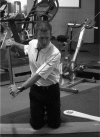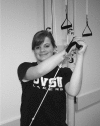The chop and lift reconsidered: integrating neuromuscular principles into orthopedic and sports rehabilitation
- PMID: 21509127
- PMCID: PMC2953333
The chop and lift reconsidered: integrating neuromuscular principles into orthopedic and sports rehabilitation
Abstract
The upper extremity bilateral PNF patterns, better known as the "chop and lift" are well known to physical therapists. These patterns which utilize spiral and diagonal motions of the upper extremity can be used for both assessment and treatment of sports and orthopedic injuries. Half kneeling and tall kneeling postures fall between low-level postures such as rolling and 4-point, and high-level postures of standing and walking. Half kneeling and tall kneeling can be considered transitional postures. When the chop and lift patterns are used in conjunction with the half and tall kneeling developmental postures, the techniques are an excellent assessment of core stability/instability. Combinations of the upper extremity patterns and the developmental postures can be powerful corrective training techniques. The combined experience of the three authors is used to describe techniques for equipment setup, testing, assessment, and treatment of athletic imbalances. These techniques require and promote instantaneous local muscular activity as developmental postures and balance reactions are incorporated. The therapeutic use of both PNF and developmental patterns has been a hallmark of rehabilitation of patients with neurologic dysfunction, but can be equally and effectively applied in the sports and orthopedic rehabilitation setting.
Figures








References
-
- Voss DE, Ionta MK, Myers BJ. Proprioceptive Neuromuscular Facilitation. Patterns and Techniques. Philadelphia, Harper & Row Publishers, 1985
-
- Knapik JJ, Bauman CL, Jones BH, et al. Preseason strength and flexibility imbalances associated with athletic injuries in female collegiate athletes. Am J Sports Med. 1992;19:76–81 - PubMed
-
- Panjabi MM. The stabilizing system of the spine. Part I: Function, dysfunction, adaptation, and enhancement. J Spinal Disorders. 1992;5:383–389 - PubMed
-
- Panjabi MM. The stabilizing system of the spine. Part II: Neutral zone and stability hypothesis. J Spinal Disorders. 1992;5:390–397 - PubMed
-
- Bouisset S, Zattara M. A sequence of postural adjustments precedes voluntary movement. Neurosci Letters. 1981;22:263–270
LinkOut - more resources
Full Text Sources
Research Materials
